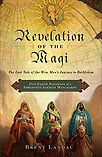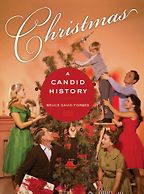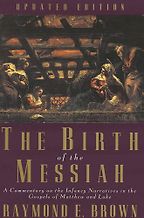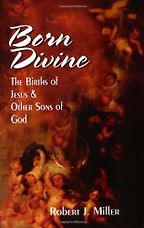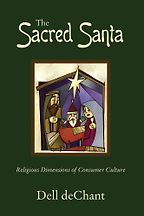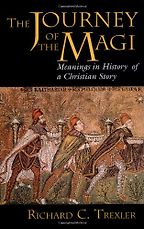Some of our readers Tweeted in with questions. For example, ‘How did Christmas trees get their start?’ ‘What are the origins and differences between Santa Claus, St Nicholas and Father Christmas?’ I thought maybe your first book offered some answers to this.
Wow. Some of these questions end up being quite hard for me to answer, since my specialty is more in the New Testament and early Christian history than the overall history of Christmas, even though it’s something I’m certainly very interested in…
Tell me about the Bruce Forbes book, Christmas: A Candid History. I think it does offer some clues to the things we celebrate and associate with Christmas but are perhaps not quite sure where they come from, such as the idea that Santa Claus lives with elves at the North Pole?
Yes. So this book is relatively short, it’s less than 200 pages, and it is just a very helpful, accessible, overview of the history of Christmas. He is a scholar, and I believe his focus is on religion and American popular culture and those are the parts of the book that are strongest.
He traces the 19th- and 20th-century evolution of Christmas, including the idea that Santa Claus is an elf. The thing that I don’t think many people realise about the poem ‘Twas the Night Before Christmas’ is how much that served to invent the mythology of Christmas, in the same way that Charles Dickens’s A Christmas Carol did. It’s not that they were merely responding to practices and beliefs that were well-known at the time.
A good analogy to this is from another holiday, the Charlie Brown Halloween special. If you look at it and see the trick or treating that the Peanuts kids are doing, you assume that this was reflecting American popular culture. In fact, in the 1960s, when this came out, trick or treating was still relatively rare. Forbes’s book is especially good for some of these more recent practices and it’s a really good reminder that the modern celebration of Christmas, as we know it today in the US, is relatively recent and very culturally specific.
Yes, my family is Dutch, and Sinterklaas or St Nicholas comes down the chimney as well, but from Spain on December 6.
Yes, different days get celebrated. And in Latin America the feast of Epiphany, the Feast of the Three Kings, is a much bigger deal than it is here. I think Americans tend to assume that Christmas has been celebrated the way it is today for quite some time, and that it is celebrated that way largely throughout the world. In fact neither of those things are true.
This brings to mind another reader question, from Mark Dowe: ‘What date of the year was Christmas really meant to fall?’ Do you know that from your research?
So Christmas ends up being fixed as the celebration of Christ’s birth, but as far as I know, we don’t have much evidence before the fourth century that Christians were celebrating on that precise date. We’ve actually got some variation.
There’s a second-century Christian author, for example, who says that Christmas was being celebrated sometime around April 20 or 21. And there’s no indication in the infancy narratives in the Gospels of Matthew and Luke that they’re envisioning this event happening in the middle of wintertime. In fact, one observation people often make about Luke’s infancy narrative is that the shepherds are said to be keeping watch over their flocks by night, and if you know a little bit about the shepherds, and the rhythms of their seasons, that is something they would have been doing in the spring. It’s not something they would have been doing in the dead of winter. So you’ll sometimes get people who look at that story in Luke and say, ‘Well, probably Jesus was born sometime in the spring.’
“The Magi story, the story of the wise men, is probably one of the best examples of places where people have read into the Bible all sorts of beliefs that are not exactly there.”
Speaking as an early Christian historian, I don’t think we have any idea whatsoever about what time of year Jesus was actually born. The infancy narratives are relatively late in terms of Christian tradition and they don’t agree very much, and they don’t really seem to have a lot of specific information about the circumstances of Jesus’s birth.
Let alone pin it on December 25.
Exactly. They don’t pin it on any specific date. Then, in the fourth century, it gets fixed on December 25. I’m not a liturgical historian, but I believe that one of the reasons for this is that the 25th was right around the time of several other prominent pagan festivals, festivals for birthdays of gods.
And, just to name two of them, one of them was a Persian god named Mithras who actually seems to have been born in cave, just as some traditions of Jesus have it. I believe his birth was celebrated right around that time.
The other god or celebration is ‘Sol Invictus’, which is Latin for ‘Invincible Sun’ and seems to have been a solar deity that was worshipped by some Romans. In fact, well into the reign of Constantine – whom we view as the emperor who really brought Christianity to the Roman Empire and converted to Christianity – there are coins of his that bear the Sol Invictus. So it’s not entirely clear how the decision gets made to fix on December 25, but it probably has something to do with those other holidays and seeking to dampen the enthusiasm or Christianise them in some way.
Get the weekly Five Books newsletter
This is something the early church did in reference to other pagan holidays as well – the great example is the Celtic holiday of Samhain, which is the antecedent of our modern Halloween. This is celebrated on November 1, and originally All Saints Day was celebrated in April/May. But, in the sixth century, it was decided that All Saints Day would fall on November 1, as a way of co-opting this pagan holiday. This was standard operating procedure for the ancient church, to take these pagan holidays, and paint them over with Christian trappings.
While on a superficial level that would certainly seem to be satisfying – that people are celebrating a Christian rather than a pagan holiday – the end result ends up being that, whether we’re talking about Christmas or Halloween or Easter, these holidays still end up, even today, having some vestiges of pagan celebrations.
What would you say was the main vestige in terms of Christmas?
The yule log. That’s a northern European practice in origin that involved building a bonfire or setting fire to a huge log as a way of warding off the extreme darkness of that time of year in northern Europe. I think the Christmas tree is also… but I don’t know exactly where that comes from.
Tell me about the Raymond Brown book, The Birth of the Messiah.
Raymond Brown’s book is great because it is the only full-length scholarly commentary on the infancy narratives of Matthew and Luke. For somebody who has grown up listening to the Christmas stories, or has made the effort to read the Gospel stories of Jesus’s birth in Matthew and Luke, but has questions about any of the particular things that are said, questions of historicity, all of that can be found in Brown’s book.
Not only is there detailed word-by-word explanation of what every single verse means, but there are also a number of helpful appendices that deal with specific issues that come up in the study of the infancy narratives. For example, the disagreements between Luke and Matthew in terms of Jesus’s genealogy.
“The accounts of Jesus’s birth haven’t ever been that influential in how people actually celebrate Christmas”
There’s also the question of the historicity of the census that Luke says was taken while Quirinius was Governor: Luke doesn’t quite seem to be getting his historical information correctly. Also, the question of whether or not Jesus was born in Bethlehem and what the historical arguments for that are. They’re really not very good. Most biblical scholars believe that Jesus was born in Nazareth, in Galilee, and that he was later said to have been born in Bethlehem because that was where the Messiah was believed to have to come from.
According to the Old Testament prophecies, you mean?
Exactly.
But in two of the Gospels it does say he was born in Bethlehem.
Yes, in the infancy narratives of Matthew and Luke, it says he is born in Bethlehem. You would think, since these two infancy narratives agree on it, that that would speak favourably to historical credibility. The problem is that Matthew and Luke have very different ways of explaining why Jesus is born in Bethlehem.
In Luke you have the census. The family lives in Nazareth and they only go down to Bethlehem because everybody is required to go back to their home town. Jesus is born while they’re there and then they go back to Nazareth, because that’s where they live.
Five Books interviews are expensive to produce. If you're enjoying this interview, please support us by donating a small amount.
In Matthew, on the other hand, it seems as if Jesus is born in Bethlehem because that’s where his parents live. So when the Magi come and visit Jesus, it says that the star shone over the place where the child was. It doesn’t say it was a manger like in Luke; it says it stood over the house where the child was. Presumably they just lived in Bethlehem and they only left because Herod was trying to kill Jesus and resettled in Nazareth because of that.
So Matthew and Luke disagree and Mark never says anything about Jesus being born in Bethlehem. John, interestingly enough, has a scene in chapter 7 where some people are debating whether or not Jesus is the Messiah. And somebody essentially says, ‘He can’t be the Messiah, the Messiah is supposed to come from Bethlehem.’ This is presented in John with no trace of irony, as if John doesn’t even know this tradition that Jesus was born in Bethlehem. It’s just stated very bluntly that he wasn’t. So this idea of Jesus being born in Bethlehem, even though that ends up being absolutely central to Christian tradition and the piety surrounding Christmas, there’s not a lot of historical information speaking of it and there’s some very good reasons to doubt that claim.
Brown is looking at sources other than the Gospels themselves? Are there lots of other sources?
He’ll look at the range of available sources. He’ll look at the Gospels, but he’ll also look at later Christian literature, at Jewish literature of the same time, the work of Roman historians, the work of Roman poets. He’s basically taking a very historical approach and trying to understand the infancy narratives as products of the time they were written in the late first century.
Tell me about the Robert Miller book, Born Divine.
I like Born Divine because it covers a decent amount of the same ground that Raymond Brown’s book does, but it does a couple of things differently. First of all, it’s not quite as dense as Raymond Brown. Not that Raymond Brown is difficult to read, but it’s an 800-page book, whereas Born Divine is much less intimidating.
The thing that really sets Born Divine apart is that it spends a lot of time on other stories about the births of famous people or divine beings, whether we’re talking about somebody like Alexander the Great or Plato or the Greek god Hermes. It talks a lot about other birth stories of that time.
And the thing that it does that I like the most, because it connects up with the research I do, is it spends much more time talking about the stories of Jesus’s birth and childhood that appear outside of the New Testament, in what’s called early Christian apocryphal literature. So it goes through the infancy Gospel of Thomas, which talks about Jesus as a child, and a very badly behaving child. It talks about the infancy Gospel of James, which tells the whole story of Mary’s upbringing, and it goes into even later compositions, which is something Raymond Brown doesn’t spend a lot of time on, because his focus is really on the canonical narratives. In terms of understanding the whole tradition and the whole background of the stories of Jesus’s birth, I think that Miller’s book ends up being more well-rounded.
Do you think that if you’re a devout Christian, some of these books may be a little bit hard to take?
Absolutely. It’s a challenge, because there are a number of aspects of the Gospel stories of Jesus that have a fair amount of historical material in them. Let’s take the account of Jesus’s death. Some scholars would quibble with some of the details about Jesus’s death – for example, does he really have this dialogue with the repentant thief? But the basic historicity of the event – that Jesus was crucified under Pontius Pilate for some kind of political crime (namely for being thought to be or calling himself King of the Jews), that stuff is all very historical.
The problem with the infancy narratives is that they’re the least historical of the early Christian tradition. They’re also one of the latest parts. Early Christians were much more interested in the stories of Jesus’s death, the sayings of Jesus, his parables and other wise sayings, and the miracles that he performed.
“In terms of how Christmas gets celebrated in medieval and Renaissance Europe, it’s basically one big party – it’s an excuse to get drunk and eat lots of food for several days on end. ”
Which makes it difficult for a historian like me, when we’re talking about these kinds of things at Christmas time and people want to know more about these stories that they love so much. I have to try and gently suggest that there are reasons to be doubtful about the factual accuracy of this material. They’re still very beautiful stories, and things don’t necessarily have to be historically factual to be true on some religious or spiritual level. But you’re right, if a person is extremely devout, the standard scholarly interpretation of the Christmas story is hard to look at.
Next on your list is The Sacred Santa.
This is a really neat book. It’s a bit different from the other ones I’ve mentioned. The premise of this book is the lament you get every year, that Christmas is becoming less and less about Christ and more and more secular, and more and more removed from its religious roots, particularly in America. It seems like every single Christmas there ends up being some largely manufactured outrage about how some shopkeeper somewhere didn’t say Merry Christmas to somebody or somebody complained about a nativity scene that was in front of somebody’s house or a church. So you get all this anger and frustration that Christmas is somehow being compromised as a religious holiday.
What is interesting is that Dell deChant, the author of the book, says that, actually, the modern celebration of Christmas is profoundly religious – it’s just not a religion in the way that most of us are used to looking at one, or conceiving of a religion. It’s got its rituals, it’s got its god, and that god is Santa Claus. One of the most interesting points that the book makes is just how angry and upset people get if anybody is so foolish as to say in public, ‘Well, Santa Claus doesn’t exist!’ There have been stories of teachers who have got into terrible trouble for saying that around children in their classes. Anybody who says that is likely to be labelled as a grinch – even though the fact remains that most of us adults don’t actually believe that Santa Claus exists. We are very comfortable with the idea of this being a mythology that pervades the holiday, and even if there’s not a lot of evidence to believe that somebody like Santa lived up in the North Pole, that this is something to take seriously.
So it hasn’t got much to do with the original Christmas story, but it’s taken on a life of its own as a different religion?
Yes, it’s become a religious holiday and it doesn’t really have much to do with the account of Jesus’s birth in the New Testament. But, then again, those accounts have never really been all that central to the way Christmas was actually celebrated. There are some exceptions.
“The word it uses to describe the entourage of Magi who travel with the star is a word that usually means a small army.”
The wise men, the Magi, bring gifts, and that’s probably something that influences the tradition of gift-giving. But in terms of how Christmas gets celebrated in medieval and Renaissance Europe, it’s basically one big party – it’s an excuse to get drunk and eat lots of food for several days on end. That focus on consumption and on food and drink is still very much with us in the celebration of Christmas. People may say Jesus is the reason for the season, but the accounts of Jesus’s birth haven’t ever been that influential in how people actually celebrate Christmas.
Your last book is closer to your own research, Richard Trexler’s Journey of the Magi. Epiphany, when the three kings came, was a reasonably important holiday to me growing up, and I was surprised when I got married and my British husband didn’t seem to celebrate January 6. He pointed out that the wise men don’t make much of an appearance in the Bible at all, and I said ‘Oh what nonsense!’ and went to look it up. I was forced to admit that the reference is very vague…
It is absolutely very vague.
Tell me about this book and what we need to know.
The Magi story, the story of the wise men, is probably one of the best examples of places where people have read into the Bible all sorts of beliefs that are not exactly there. For example, the idea that there are three of them, Matthew’s Gospel never says that. Matthew says that there were three gifts – gold, frankincense and myrrh. So it ends up being a deduction on that basis, that there are three. Matthew never says they are kings. That is an interpretation that is probably based on some parts of the Old Testament, particularly the psalms, that deal with kings bringing tribute to a ruler of Israel. The names people are familiar with – Balthazar, Caspar and Melchior – don’t appear in the New Testament. In fact they only show up, for the first time, in a sixth-century source. So there are lots of interpretations and extra layers of interpretation that have gotten added on to the actual Gospel story, beyond what Matthew has written.
What Richard Trexler’s book is doing is, firstly, exploring how this interpretation began in early Christianity, how these details start getting added in one by one. He takes a long historical view of the evolution of traditions about the wise men, and goes up to the 18th or 19th century. One of the things he spends a lot of time on is how the Magi end up, in the Middle Ages, being interpreted as kings. Apparently there were a number of actual kings who really co-opted the symbol of the Magi, envisioning themselves in this role, and so there would be nativity plays where it would actually be royalty that would take on the part of the Magi.
Why do we celebrate their arrival on January 6, given they’re supposed to come when Jesus is born?
It’s tricky. The reason they come when Jesus is born, at least in the harmonised version, is because you need to have the shepherds and the Magi all there at the same time – otherwise it’s not a complete Christmas scene. Luke’s Gospel is very clear that the shepherds show up at the birthplace of Jesus quite soon after Jesus’s birth. But Matthew is a lot more vague on when the wise men show up. It doesn’t necessarily seem that they show up right at the moment of Jesus’s birth.
There are even some hints, in Matthew’s story, that maybe Matthew is envisioning that the Magi showed up when Jesus was about two years old. The reason for that is that after the Magi go and talk to King Herod, King Herod asks them about the star that they had seen, and exactly what time the star had appeared. Then, a little bit later, after the Magi don’t return to Herod, it says that he went and killed all the children in Bethlehem under age two, because of the information that the wise men had given him about when the star appeared. Readers of Matthew have put two and two together and suggested, ‘Oh, so the Magi must have seen the star in their country at the moment Jesus was born, and started travelling soon thereafter, and it took them approximately two years to get there.’ Matthew never spells all of that out, but that seems to be one of the standard interpretations.
In terms of why it gets connected up with January 6, one of the interesting things is that in eastern Christian churches, in Palestine, Syria, and further east, January 6 ends up actually being more ingrained as the time for the celebration of Jesus’s birth. My guess is that it stays on as a significant date just because it was so influential for the early church, and hence you have this 12-day sacred season, between December 25 and January 6. But there aren’t a lot of traditions in early Christianity that say the Magi showed up 12 days after Jesus was born. Some late Irish texts make this claim, but reasons for associating the Magi with that date seem to be much more because that was when the eastern Church identified the date of Christmas.
Lastly, do you want to tell me a bit about your own book, which sounds fascinating? It is, in part, a translation of a third- or fourth-century Christian text, and what it says about the Magi.
Yes, The Revelation of the Magi—which is translated into English for the first time in my book—is by far the longest and most complex and certainly the most strange account of who the Magi were, how they knew about the significance of the star, and what happened when the star itself actually appeared. It places the Magi at the very, very east of the inhabited world, in a land that seems to be equivalent to China. They’ve had this prophecy that they’ve been passing down for thousands of years, expecting a star that signalled the birth of a god in a human form. So they’re actually waiting for the star, and they’re not surprised when it shows up.
What’s interesting is that when the star does show up, it descends to the place where the Magi are praying and it actually transforms into a human being. The text makes it clear that this human being is Jesus himself in the form of a star. So The Revelation of the Magi ends up doing something very different in terms of what early Christians thought about the star of Bethlehem. There were certainly Christians who looked at Matthew’s account of the star of Bethlehem and thought, this star is behaving very strangely, so it’s probably not an ordinary star. Some of them thought it was the holy spirit, some of them thought it was an angel. But this is the only early Christian text that actually says, the Star of Bethlehem and Jesus Christ are actually the same thing.
And don’t you also say there could have been as many as 12 wise men?
That’s one of the traditions that is in The Revelation of the Magi. Early on there is a list of the names of 12 Magi. It’s not clear whether that was part of the original text. It never says there were three, and there are actually some hints in the text that the story may envision an even larger group of Magi. That’s because the word it uses to describe the entourage of Magi who travel with the star is a word that usually means a small army. So we’re not talking about a handful of Magi. The earliest form of the text may actually have envisioned hundreds of Magi following along.
What language did you translate the text from?
It was in Syriac, which is an ancient Christian language related to Aramaic which was used in the eastern regions of the early Christian church.
Interview by Sophie Roell, Editor
December 24, 2010. Updated: October 14, 2022
Five Books aims to keep its book recommendations and interviews up to date. If you are the interviewee and would like to update your choice of books (or even just what you say about them) please email us at [email protected]

